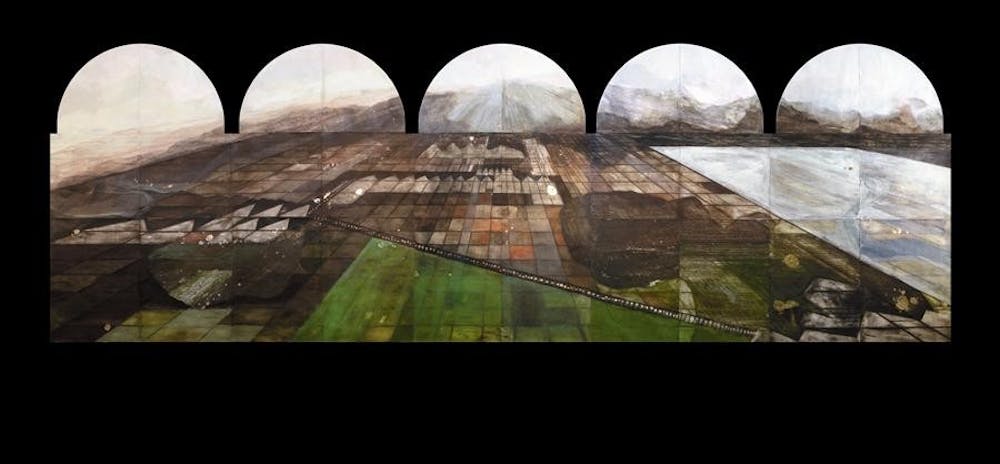Environmental awareness meets art this month with Future and Forgotten Landscapes, a series of painted billboards focused on environmental health in Bloomington.
The School of Fine Arts Gallery organized the call for submissions in November. From those submissions, four pieces by Shelley Given, Sage Dawson, Megan Abajian and Max Heller were selected to be displayed around town.
The exhibition is sponsored by the SoFA Gallery, Your Art Here and ArtsWeek.
“Subdividing” – Shelley Given
A current Bloomington resident and Midwest native, Given said she has always been interested in the way Midwestern landscapes have changed over time.
Given said Indiana’s land was once home to substantial forests, then became farmland and is now falling victim to urban sprawl.
“I’m very conscious of the change from farmland to subdivision, agrarian to suburban,” she said.
Given’s piece, titled “Subdividing,” is a double-exposure, black-and-white photograph.
On one side is a white suburban house with a satellite dish in the foreground and a line of houses in the background. This morphs into a machine shed from Given’s grandfather’s farm with a field in the background.
An adjunct professor in the Henry Radford Hope School of Fine Arts, Given said she answered the call for art because the idea of Future and Forgotten Landscapes is important to her and the concept is an alternative means for exhibiting and promoting the arts.
“Something that people find really important, especially in college, is sports,” she said, “which is great, but there’s more out there. It’s nice to see other departments in the community.”
“Itinerary Map Through Space and Time” – Sage Dawson
An artist based out of Missouri, Dawson said her work draws upon maps in order to explore experiences and the landscape.
“An itinerary map is a type of map that documents the experience of someone as they move through the landscape from a starting point to an end point,” Dawson said. “It documents time and the experience of moving through space.”
Dawson’s piece, created using painting and printmaking, is an aerial view of a landscape and incorporates map imagery with the use of a grid.
“I felt like my work really fit the theme well,” Dawson said.
While fit was an important factor in Dawson’s decision to answer the call for art, she also felt like the nature of the project was vital.
“Galleries have come to define what it means to exhibit art,” she said. “Billboards are obviously public in a way that work in a gallery is not. People who aren’t interested in art are exposed. These are current issues, so they matter to people outside of the art world.”
“Donnadio” – Megan Abajian
Abajian, who got her Master of Fine Arts painting degree from IU in 2008, created her piece in grad school for her thesis show.
Abajian said for a lot of her work she thinks internally.
“When you think of a landscape, a lot of people think of the outside world, but you forget that the internal body can also be an environment,” she said.
Abajian said “Donnadio” follows this line of thinking but that the abstractions in the painting also speak to a traditional landscape.
Abajian also said the idea of her art being on a billboard appealed to her.
“We live in a studio and very rarely do we get to invite the outside world in, and there is a novel idea of having this huge abstraction on a billboard in rural Indiana,” Abajian said. “It’s a little out of place and I think because it’s a little unusual it would gather more attention.”
“The Great Seal” – Max Heller
Heller, an artist in North Carolina, said he liked the idea of Future and Forgotten Landscapes because he enjoyed the ambiguity of the concept.
“I like the idea of things that are forgotten but you should remember, reminding people of the past and the future, which is always wide open,” Heller said. “That’s not to say that I’m optimistic, but I understand that, as much as we try, we can’t control the future.”
Heller’s piece is a picture of the Great Seal from the back of the $1 bill, digitally altered and placed on a darkened landscape.
“I removed the eye from the pyramid completely because it’s like Providence has closed its eye,” Heller said about the eye being above the pyramid, which is supposed to represent Providence watching over the country.
Heller said he created this piece in light of the nation’s recent monetary troubles.
“I’m aware of what’s going on around me,” he said. “It’s about the wider landscape of American life.”
Artists create billboards to highlight environmental awareness during February

Get stories like this in your inbox
Subscribe





